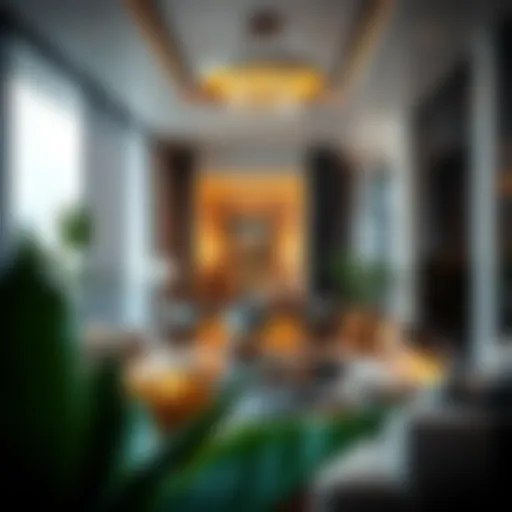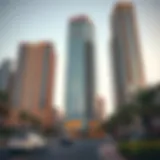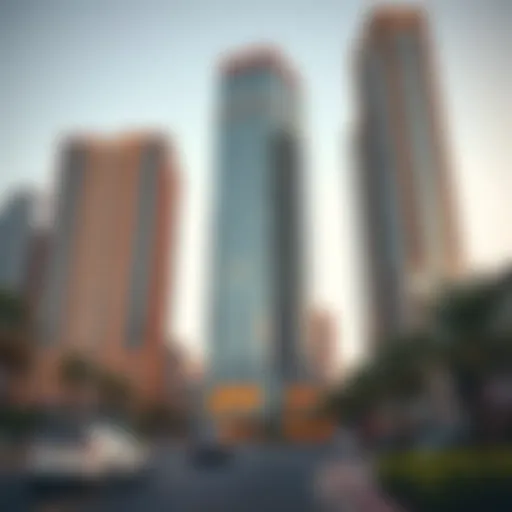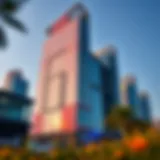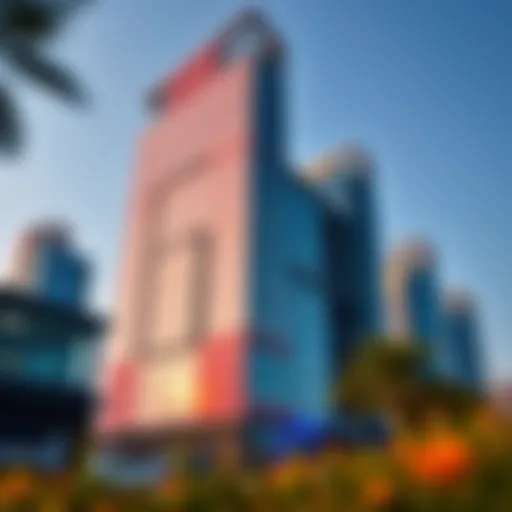Discovering the Rich Heritage of Old Town Dubai Souk


Intro
Old Town Dubai Souk is much more than a collection of shops and food stalls; it stands as a vibrant testament to the rich tapestry of cultural heritage that Dubai boasts. This bustling marketplace showcases the juxtaposition of tradition and modernity, which is a hallmark of the city itself. Visitors are greeted by the charming scent of spices wafting through the air, mingling with the sounds of artisans diligently crafting their goods. Each corner of the souk tells a story—of a city that has risen from humble fishing village roots to a global hub of commerce and culture.
In this exploration, we will journey through the architectural wonders of the souk, delve into the bustle of its traditional markets, and appreciate the culinary experiences that make this locale a linchpin of Dubai's identity. By examining the artisanal trades, community interactions, and unique offerings that define the Old Town Dubai Souk, we will uncover its integral role in the city’s evolving narrative.
Market Trends and Analysis
Current Market Overview
The Old Town Dubai Souk is nestled within the larger context of Dubai's ambitious urban development plans. While skyscrapers scrape the skyline, the souk retains its charm, drawing in both tourists and locals. Currently, the market thrives on a blend of genuine craftsmanship and contemporary consumer trends. Arts and crafts, textiles, and local spices remain in high demand. Whether it's a handcrafted piece of jewelry or a packet of traditional spices, the appeal lies in authenticity.
Future Projections
As the world increasingly pursues unique experiences in tourism, the Old Town Dubai Souk stands poised for growth. The city’s commitment to preserving cultural heritage while fostering tourism means that the souk will likely expand its offerings. Insights indicate a potential increase in themed events and artisan markets that reflect the dynamism of Dubai’s culture. This trend suggests the souk will not only remain a retail hub but also evolve into a centerpiece for cultural exchange within the region.
Investment Opportunities
High-Growth Areas
Investors looking to tap into the vibrancy of the Old Town should consider the artisan and culinary sectors. Properties around the souk are positioned for appreciation, driven by increased foot traffic from both tourists and residents. The artisan shops that populate the lanes of the souk are particularly of interest; they not only capture the local spirit but also possess a unique broker’s point for international market penetration.
Rental Yield Insights
Investing in properties near the Old Town Dubai Souk can present lucrative rental opportunities. Given the increasing popularity of the area for both short-term and long-term stays, rental yields can be substantial. According to the latest reports from various real estate analysts, properties close to active markets tend to achieve a premium rent, owing to their location and cultural significance.
"Dubai's Old Town Souk is a microcosm of the city’s grand narrative—where heritage and modern vibrancy intersect with each and every visitor interaction."
For those considering a deeper engagement with the locale, attention should also be given to local regulations and market dynamics, ensuring a well-rounded understanding of investment potential.
Historical Context of Old Town Dubai Souk
Understanding the historical context of Old Town Dubai Souk is vital for any analysis of its present-day significance. The souk is a living testament to the resilience of traditional market practices and the rich cultural tapestry of Dubai. It’s more than just a marketplace; it’s where history, commerce, and community converge, making it a focal point of local identity and continuity amid rapid urban change.
Origins of the Souk
The origins of the Old Town Dubai Souk trace back to a time when Dubai was a modest fishing and pearling village. Nestled along the banks of Dubai Creek, early merchants set up stalls to trade spices, textiles, and goods essential for daily life. The souk was born out of necessity, serving as an essential hub for supplies and cultural exchanges.
Picture this: bustling pathways filled with the aromas of saffron and cardamom, the vibrant colors of handmade textiles contrasting against the arid backdrop. These early marketplaces not only fostered trade but also brought together individuals from diverse backgrounds. This melting pot of cultures began the transformation of Dubai into a cosmopolitan city, where the souk played a pivotal role in shaping community bonds.
Cultural Influences Over Time
As trade routes flourished, the Old Town Dubai Souk became a microcosm of cultural influences that have shaped its character over centuries. Persian, Indian, and other regional traders contributed their distinct cultural identities, reflected in the goods sold as well as the vibrant atmosphere that surrounded the souk.
The interactions among different communities introduced new flavors and crafts to the market, which over time morphed into what we see today. This cultural amalgamation still resonates in the souk's architecture and the eclectic mix of products offered, each echoing tales of trade and travel. Local artisans continue to weave these influences into their crafts, ensuring that the rich heritage remains palpable.
Evolution of Market Practices
The evolution of market practices within the Old Town Dubai Souk illustrates adaptive resilience to changing economic landscapes. Over time, traditional barter systems began transitioning into more structured commercial activities, keeping pace with globalization while preserving its soul. Today, you can observe stalls displaying everything from locally-made handicrafts to contemporary fashion—a nod to both tradition and modernity.
As more tourists flock to explore the souk, commercial practices blend heritage with innovation. Marketers engage in immersive experiences—workshops, live demonstrations, and interactive sessions that allow visitors to connect deeply with the goods. This shift illustrates how the souk has adapted to new market demands without losing its identity.
Architectural Features
The architectural aspects of Old Town Dubai Souk are not merely aesthetic; they serve as a reflection of the region's cultural richness and historical continuity. They capture the essence of a time when trade was the lifeblood of the community, making the souk a vital hub for both commerce and social interactions. This section explores the traditional design elements woven into the fabric of the souk, contemporary additions that respect the original architecture, and the significance of open-air markets in urban settings.


Design Elements of Traditional Souks
Traditional souks are emblematic of Middle Eastern architecture, showcasing ornate designs that tell stories of the past. Key features often include:
- Arched Doorways: These entrances invite visitors in, creating a sense of intrigue and wonder, almost as if stepping back in time.
- Wind Towers (Barjeel): An ingenious solution to Dubai’s hot climate, these structures cool the air naturally, showing how local adaptation meets architectural innovation.
- Mosaic Tile Work: Vibrant colors and intricate patterns dominate the walls, capturing the eye and creating a warm, welcoming environment.
The layout of the souk is intentionally organic, lacking the rigid structures often found in modern markets. Narrow alleyways twist and turn, guiding visitors through a labyrinth of shops, each filled to the brim with spices, textiles, and handcrafted goods. This design fosters an intimate shopping experience, enhancing community connections.
Contemporary Additions to the Souk
In recent years, modern influences have found their way into the souk, striking a balance between preserving heritage and adapting to contemporary needs. New installations respect traditional aesthetics while also enhancing functionality.
- Eco-Friendly Materials: The use of materials like sustainable timber for new stalls contributes to environmental conservation efforts, reflecting a planet-conscious ethos.
- Advanced Amenities: Facilities like improved lighting, ventilation, and waste management systems have been introduced subtly, allowing visitors the comforts of modernity without overshadowing historical significance.
By incorporating these contemporary features, the souk remains relevant without losing its soul, inviting both locals and tourists to explore its allure.
Significance of Open-Air Markets
Open-air markets like Old Town Dubai Souk hold substantial importance in urban life. They act as a linchpin for social interaction, reinforcing community ties while providing economic opportunities. The benefits include:
- Cultural Exchange: The souk draws a diverse clientele, creating a melting pot where cultures meet and exchange ideas through commerce.
- Local Economy Support: Artisans and small business owners flourish in this space, generating income and promoting traditional crafts.
- Tourist Attractions: Visitors flock to experience the local flavor, resulting in increased foot traffic and economic improvement for surrounding businesses.
"The charm of an open-air market is in its unpredictability; you never know what treasure you might find around the next corner."
In summary, the architectural features of the Old Town Dubai Souk—rooted in tradition yet evolving to embrace contemporary needs—illustrate the delicate balance between past and present. With its intricate designs, thoughtful enhancements, and social significance, the souk stands as a testament to the enduring character of Dubai.
Commercial Landscape of Old Town Dubai Souk
The Commercial Landscape of Old Town Dubai Souk is a vibrant tapestry woven with the threads of tradition and modernity. It not only serves as a commercial hub for countless visitors but also mirrors the cultural heart of the city. Here, the past meets the present, creating an engaging atmosphere for shopkeepers and tourists alike. The significance of this landscape can hardly be overstated; it impacts local economies, sustains traditional crafts, and fosters community interaction. Each corner of the souk bustles with life, showcasing an array of goods that tell their own unique stories.
Types of Goods Available
Textiles and Fashion
Textiles in the Old Town Dubai Souk offer a kaleidoscope of colors and patterns. From flowing abayas to intricately woven scarves, every fabric has its place. These textiles not only represent Emirati culture but also invite visitors to expand their wardrobes with unique finds that tell a story. The key characteristic of textiles here is their rich artistry that draws on historical craftsmanship combined with modern styles.
Moreover, textiles serve as a beneficial choice for those looking to explore Dubai's heritage through fashion. Unique features like hand-embroidered designs and organic materials elevate these products, appealing to environmentally conscious shoppers. However, one must consider the varying price points; some exquisite pieces may come with a hefty price tag, which might be a drawback for budget travelers.
Spices and Culinary Ingredients
The spice section of the souk is a sensory delight. It offers a dazzling array inviting you into the world of flavors, from earthy cumin to aromatic saffron. This aspect of the souk enriches culinary experiences, allowing both locals and visitors to dive into Emirati—the cultural melting pot where flavors mingle and expand one's palate.
The key characteristic of spices available is their freshness, often with sellers eager to share their knowledge of traditional dishes. Purchasing spices from the souk feels like adding a piece of Dubai to your kitchen, making it a popular choice among food enthusiasts looking to recreate authentic dishes. Yet, a unique aspect one should watch out for is the careful selection of spices, as the sheer variety can be overwhelming, possibly leading to purchasing items that may not suit every household or recipe.
Handicrafts and Souvenirs
Handicrafts are at the soul of the Dubai Souk, embodying the skill and heritage of local artisans. These goods range from intricate pottery to stunningly designed jewelry, making perfect souvenirs that hold cultural significance. One can see the essence of Emirati life reflected in each piece; they carry stories of the land and its people, making them not just objects but narratives.
The key characteristic here lies in the craftsmanship, often handmade, which distinguishes these souvenirs from mass-produced alternatives. This uniqueness boosts their appeal and underlines their importance in supporting local artisans who thrive on the heritage of their crafts. However, as charming as these items are, buyer's need to be aware that their authenticity and quality can vary; some knock-offs may infiltrate even the most reputed stalls.
Role of Artisans in the Economy
Artisans play a pivotal role in the Old Town Dubai Souk, acting as the lifeblood of this cultural landmark. They are not just vendors but custodians of tradition, passing down techniques that have been honed over generations. This creative workforce supports the local economy significantly, as each transaction helps sustain livelihoods and keeps traditional practices alive.
Artisans often engage in personal storytelling, connecting with customers, which adds to the shopping experience's richness. The products they sell aren't merely items; they are manifestations of their dedication to preserving culture while adapting to contemporary market demands. Thus, the artisans not only keep the soul of the market alive but also contribute to the overall economic fabric of the locality, making them invaluable to both the community and the visitors who flock to the souk.
Competition with Modern Retail


As the world spins forward, the Old Town Dubai Souk finds itself navigating the choppy waters of competition with modern retail. Mall culture, with its pristine environment and brand-name shops, attracts many consumers. However, the souk's unique charm lies in its human connection, vibrant interactions, and the experience of shopping in an open marketplace rich with aromas and colors.
While modern retail offers efficiency and convenience, it lacks the narrative depth found in traditional souks. Here, shoppers engage with history, immerse themselves in culture, and develop personal relationships with the sellers. These aspects can’t be bought or replicated in contemporary shopping spaces. The challenge for the souk is to blend modern retail strategies while retaining its authenticity, ensuring it remains a vital part of Dubai's community and visitors’ experience.
Culinary Scene in the Souk
The culinary landscape of Old Town Dubai Souk offers a vibrant tapestry of flavors, aromas, and cultural influences that reflect the heart and soul of this lively marketplace. Not merely a place to purchase goods, the souk serves as a culinary crossroads where local traditions mingle with international tastes, creating a rich gastronomic experience that beckons both locals and tourists alike. The significance of this scene cannot be overstated; it plays a crucial role in preserving traditions while also embracing modern influences, making it an essential aspect of the souk's allure.
Traditional Emirati Cuisine
At the core of the culinary offerings is traditional Emirati cuisine, a reflection of the UAE's rich history and cultural heritage. Dishes such as Al Harees, a hearty porridge of wheat and meat, or Machboos, a spiced rice dish, showcase the essence of local flavors. These dishes often utilize spices like saffron, cardamom, and cinnamon, which have been imported through centuries of trade and interaction.
Visitors to the souk can indulge in street-side stalls and family-run restaurants that serve these authentic dishes, often prepared using age-old recipes passed down through generations. Eating in the souk is not just about satisfying hunger; it's an immersive experience that invites diners to understand the culture and history behind each bite.
"Food is a language we all understand; it connects us through flavor and tradition."
Influence of International Flavors
The influence of international flavors in the culinary scene of Old Town Dubai Souk is profound. As the UAE is a melting pot of cultures, the cuisine reflects this diversity. From Indian curries to Lebanese shawarma, the souk boasts a variety that satisfies even the most discerning palate.
Many eateries blend this cultural richness to create fusion dishes that are unique to Dubai. For example, one might find karak tea served alongside Italian pastries, illustrating how different culinary traditions can coexist and adapt within the same environment. This merging of flavors not only satisfies tourists craving something familiar but also encourages locals to explore and integrate new culinary techniques into their traditional fare.
Dining Experiences: From Street Food to Fine Dining
The dining experience in the souk is eclectic, ranging from street food shacks with sizzling items over charcoal grills to sumptuous sit-down restaurants that offer an upscale dining ambiance. Street food is popular not just for its affordability, but also for the authentic flavors that characterize the bustling food scene.
On any given day, you can witness locals and tourists scurrying to grab a quick bite of falafel wraps or shish tawook, all while enjoying the communal vibe of eating at shared tables. However, the souk also features more refined dining options, where chefs take inspiration from traditional cooking methods and elevate dishes to new heights.
Here, the culinary scene does more than satisfy hunger; it contributes to the social fabric of the area. Dining in the souk becomes an experience that fosters community interaction, showcasing how the culinary arts preserve and advance the cultural narrative of Old Town Dubai.
Cultural Significance of the Souk
The Old Town Dubai Souk is not just a collection of stalls selling items; it is a vibrant tapestry of the city’s identity, woven through centuries of cultural exchange. It stands as a symbol embodying the enduring spirit of community, tradition, and commerce. Here, in this hub, the past meets the present, reflecting the dynamic evolution of Dubai itself. The souk offers an immersive experience that reveals the heart and soul of the local culture, making its significance profound and multi-faceted.
Community and Social Interactions
When stepping into the Old Town Dubai Souk, one doesn’t just become a customer; instead, one becomes part of a living community. The locals frequent the souk not just for shopping but to engage in social interactions. Stalls are often manned by artisans and merchants who have stories to tell. A visitor can find oneself sipping mint tea while sharing tales with a textile vendor, fostering connections that transcend mere transaction. This mingling allows both residents and tourists to develop a deeper understanding of the Emirati culture and hospitality.
A few key social interactions include:
- Conversations about traditional crafting techniques with local artisans.
- Community gatherings during special occasions, where people come together to celebrate and share their heritage.
- Informal trading practices where bartering is sometimes welcome, enhancing the cultural experience.
Festivals and Events Hosted
The Old Town Dubai Souk often transforms into a stage for various festivals throughout the year, emphasizing its role as a cultural epicenter. Events celebrate religious holidays, historical commemorations, and crafts exhibitions, attracting both locals and tourists eager to experience these vibrant festivities.
Key events frequently held at the souk are:
- Eid Celebrations: Marking the end of Ramadan, the souk showcases special activities, traditional music, and cultural dance performances.
- Dubai Shopping Festival: The souk features unique promotions and local handicrafts, drawing attention to authentic goods.
- Heritage Days: Events dedicated to traditional Emirati crafts and cuisine, allowing visitors to indulge and learn simultaneously.
These events not only enrich the souk’s atmosphere but also serve as platforms to keep traditions alive. They infuse life into the alleys, turning commercial spaces into lively arenas filled with joy and cultural pride.
Artistic Expressions and Performances
Artistic expressions thrive in the Old Town Dubai Souk, where creativity flourishes through various forms. From pottery to textiles, every piece has a story backed by a traditional technique. The octagonal pattern found in local designs often symbolizes connectivity and unity, intrinsic to Emirati lore.
Regular artistic performances and exhibitions showcase local talents:


- Live Music: Traditional bands often set up, providing an auditory backdrop that enriches the shopping experience.
- Dance Performances: Folkloric dance troupes may perform, showcasing the fluidity of Emirati art forms and engaging audiences with cultural narratives.
- Workshops: Visitors may participate in crafting workshops, learning skills such as pottery or weaving from local artisans. These hands-on experiences deepen their appreciation for traditional crafts.
From bustling interactions to vibrant festivals and artistic displays, the Old Town Dubai Souk encapsulates a cultural landscape rich in meaning and significance. It connects the people of Dubai with their heritage, allowing newcomers to discover what it means to be part of the Emirati experience. Through these cultural dimensions, the souk stands not just as a market, but as a vital and enduring piece of Dubai's identity.
"In every corner of the souk, there lies a piece of history, waiting for curious souls to discover."
For further reading on Emirati culture and its community significance, visit Britannica and Wikipedia for a more detailed exploration.
Tourism in Old Town Dubai Souk
The importance of tourism in Old Town Dubai Souk is multi-faceted, touching on cultural, economic, and social dynamics. As a vibrant hub of activity, the souk attracts visitors not only from other parts of Dubai but from across the globe. Tourists flock to experience a blend of traditional culture and contemporary commerce that this market epitomizes. This section explores various elements that enhance the allure of tourism in the souk and analyzes its broader implications for the community.
Attractions for Visitors
When one steps into Old Town Dubai Souk, the sensory journey begins immediately. The vibrant sights and sounds enthrall travelers as they navigate through narrow streets lined with shops and stalls. Key attractions include:
- Textile shops showcasing an array of fabrics, from silk to cotton, all imbued with traditional patterns.
- Spice vendors whose aromatic offerings create an olfactory delight, from saffron to za'atar.
- Artisan stalls where skilled craftspeople exhibit handmade jewelry and pottery, embodying years of craftsmanship.
- Culinary spots ranging from eye-catching street food carts to upscale dining experiences, allowing visitors to savor traditional Emirati dishes.
These attractions are more than mere shopping opportunities; they encapsulate the essence of Emirati heritage and showcase the artistic talents of local artisans.
Tourist Experience: Expectations vs. Reality
Visitors often enter Old Town Dubai Souk with a myriad of expectations, drawn by glowing reviews and social media snapshots. However, reality can sometimes strike a discordant note. Key points of divergence include:
- Cultural Engagement: Many tourists anticipate engaging deeply with Emirati culture. While some shops foster interactions, others might feel somewhat transactional, leaving a desire for deeper connection.
- Authenticity: Tourists often seek authentic experiences. However, certain areas can feel commercialized, which may lead some to question the authenticity of their experience.
- Crowds and Comfort: Visitors picture a bustling market filled with vibrant life but may not anticipate the throngs of people squeezing through narrow pathways, which can hinder a leisurely exploration.
Despite these contrasts, the unique atmosphere and cultural richness still provide a rewarding experience that often exceeds expectations once visitors embrace the chaos.
Impact on Local Economy
The economic influence of tourism in Old Town Dubai Souk is considerable. It injects much-needed capital into the local economy while promoting job creation in various sectors.
- Job Opportunities: From vendors to tour guides, the souk generates employment for many locals. Contributing to the livelihood of families, it is more than just a market; it's a community cornerstone.
- Support for Local Artisans: Many small business owners rely on tourism. Tourists purchasing from local artisans ensures the preservation of traditional crafts and provides artisans with a fair income.
- Increased Investment: The influx of visitors bolsters the interest of real estate developers and business investors, leading to more infrastructural improvements and business openings, further enhancing the economy.
In essence, the symbiotic relationship between tourism and the economic vitality of Old Town Dubai Souk illustrates the market's pivotal role in maintaining both cultural integrity and economic sustainability.
"Investing in cultural tourism enriches not just the economy but the very soul of our communities."
Through this exploration of tourism within Old Town Dubai Souk, it becomes evident that while it serves as a bustling marketplace, its impact dwarfs simple commerce, bridging gaps between tradition and modernity in a way that resonates through generations.
Future Prospects of Old Town Dubai Souk
The future of Old Town Dubai Souk holds significant importance in understanding Dubai's overall transformation as a global urban center. As the city continues to grow at an exponential rate, the souk represents a tangible link to its past while adapting to modern needs. This dual role of conserving history and welcoming innovation is crucial, as it not only maintains the identity of Dubai but also serves as a focal point for economic and cultural activities.
Urban Development Plans
As the urban fabric of Dubai evolves, so too do the plans for Old Town Dubai Souk. City planners envision integrating this traditional market more deeply into the urban layout. This includes enhancing surrounding infrastructure, improving access to the souk, and creating a seamless flow between different parts of the city. Tackling congestion and incorporating public transport can make visits easier and more appealing.
For example, plans are in the works for pedestrian-friendly zones that allow visitors to stroll leisurely, without the noise and hassle of traffic. In addition, creating more vivid green spaces around the souk will invite residents and tourists alike to pause and enjoy the environment. Such developments not only beautify the area but also help to cement the souk's status as a central gathering space.
Sustainability Initiatives
In the light of increasing environmental concerns, sustainability has become a cornerstone of future planning for the Old Town Dubai Souk. Local artisans and businesses are encouraged to adopt environmentally-friendly practices. This includes promoting local products, encouraging the use of biodegradable packaging, and conserving energy in their operations.
Moreover, creating awareness about sustainable practices can help preserve traditional crafts while appealing to eco-conscious visitors. Initiatives like workshops or events centered around sustainability would further engage the community, fostering a sense of pride and responsibility toward preserving the souk's environment.
"Incorporating sustainability into the heritage of the Souk not only enhances its charm but also ensures its viability for future generations."
Maintaining Cultural Heritage Amid Modernization
As modernization sweeps through cities worldwide, Old Town Dubai Souk's challenge lies in balancing the charm of its rich cultural heritage with the demands of contemporary life. Maintaining architectural integrity while allowing for modern amenities is vital. Specific guidelines could be established to ensure any developments respect the original design of the souk, preserving its character.
Additionally, finding ways to keep traditional practices alive is essential. This might include setting up programs that support artisan craftsmanship or showcasing cultural events that reflect the region’s history. For instance, hosting events that feature local music, art, and dance can bring vibrancy to the area while appealing to tourists looking for authentic experiences.



